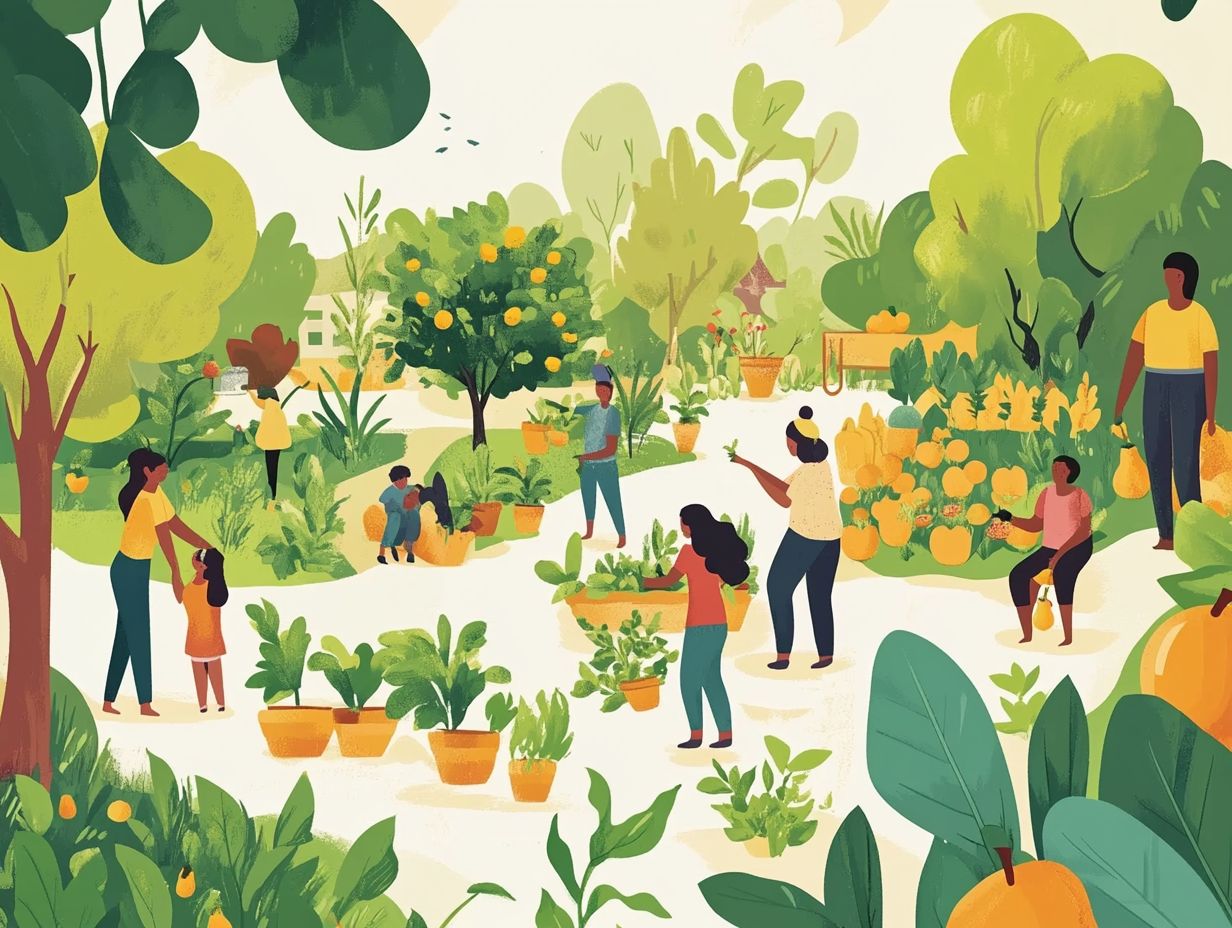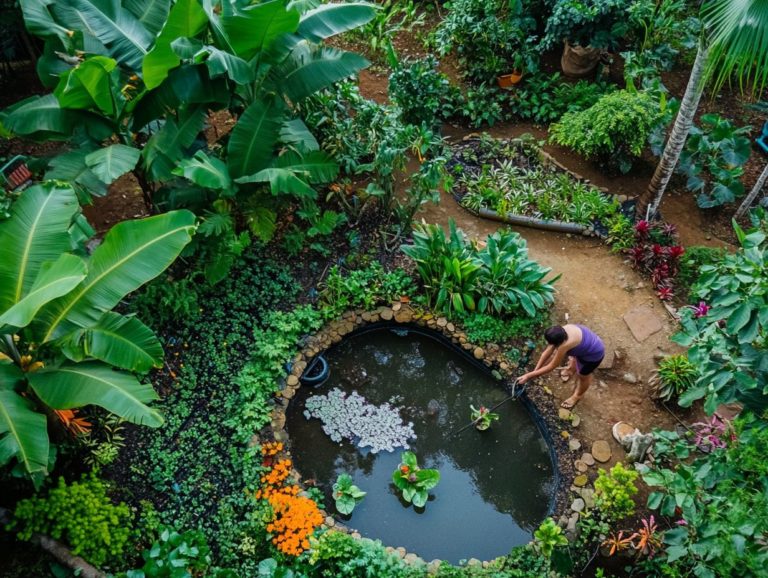17. How to Create a Community Food Forest
Community food forests are more than just patches of greenery; they are vibrant hubs where nature intertwines with community life. These spaces provide a sustainable avenue for food cultivation while nurturing social bonds.
This article delves into the concept of a community food forest. It illuminates its myriad benefits for the environment and fosters social cohesion among neighbors.
You ll uncover the essential steps to plan and design your own food forest. Learn how to choose the right plants that thrive in your locale and engage your community in the process.
Explore practical tips and insights from successful existing projects. They will empower you to cultivate a flourishing green space right in your neighborhood.
Contents
- Key Takeaways:
- What is a Community Food Forest?
- Benefits of a Community Food Forest
- Planning and Designing a Community Food Forest
- Choosing the Right Plants for a Community Food Forest
- Ensuring Sustainability and Maintenance
- How to Get the Community Involved
- Tips for Creating a Successful Community Food Forest
- Frequently Asked Questions
- What is a community food forest?
- Why should I create a community food forest?
- How do I start creating a community food forest?
- What are some important considerations for creating a community food forest?
- How can I involve the community in creating a food forest?
- What are some potential challenges of creating a community food forest?
Key Takeaways:

What is a Community Food Forest?
Picture your neighborhood transforming into a collaborative green haven. You and your neighbors can come together to cultivate a rich tapestry of edible plants think fruit trees, vibrant shrubs, and fragrant herbs.
This space not only promotes sustainable gardening but also elevates urban agriculture to new heights. These communal gardens are a display of sustainable gardening, expertly layering plants and creating microclimates that foster biodiversity.
They highlight the vital role you play in food production and environmental stewardship. This reinforces the connection between community and nature.
Defining the Concept
The concept of a community food forest invites you to envision a shared space. Here, a diverse array of plant species thrives, guided by sustainable gardening practices that work with nature and promote ecological balance. To learn more about fostering these initiatives, check out how to develop community leadership in permaculture.
This dynamic approach enhances local biodiversity while championing sustainability. You and your neighbors can cultivate food in ways that minimize environmental impact.
By incorporating native plants and employing planting different plants together that help each other grow, you ll likely notice improved soil health and fewer pest issues. This leads to bountiful yields.
These gardens also become vibrant interactive spaces. They are perfect for engaging in workshops, exchanging gardening wisdom, and nurturing connections among residents.
As you and your fellow participants work side by side, you ll enjoy the fresh produce and strengthen social ties. This cultivates a genuine sense of ownership over your shared environment.
Benefits of a Community Food Forest
Community food forests offer a wealth of gardening benefits that extend far beyond mere aesthetics. They play a crucial role in enhancing the environment and fostering social cohesion.
These vibrant green spaces position themselves as essential components of urban agriculture and climate-smart initiatives. By nurturing biodiversity, improving air quality, and promoting water conservation, they transform into vital hubs for community engagement and environmental education.
Environmental and Social Benefits
Community food forests offer impressive environmental benefits. They enhance biodiversity and soil health while increasing carbon sequestration.
These vibrant green spaces serve as vital habitats for various plants and wildlife. They create an ecosystem where pollinators like bees and butterflies thrive.
Beyond providing fresh produce, community food forests encourage sustainable practices like composting and rainwater harvesting. These practices enrich both soil and water systems.
Socially, these spaces become gathering spots that foster connections among residents. They break down barriers and promote collaborative projects.
Local workshops and food-sharing events elevate culinary skills and cultivate a sense of unity. Local vendors also enjoy economic benefits from increased foot traffic.
Ultimately, these initiatives create a thriving ecological balance that enriches both the environment and the social fabric of your neighborhood.
Planning and Designing a Community Food Forest

Planning a community food forest means taking a strategic approach to garden design. This emphasizes sustainable gardening practices, meticulous soil preparation, and effective natural irrigation techniques.
Understanding microclimates and selecting the right planting layers are crucial. These choices ensure a thriving ecosystem that meets community needs.
Key Considerations and Steps
Focus on a few key considerations when planning a community food forest: effective site selection, community involvement, and a design that adapts to maintenance needs.
Choosing the right site is essential. It will determine how well the forest flourishes.
Evaluate factors like sunlight, soil quality, and water access. These elements deserve thorough evaluation.
Involving the community in planning is critical. It ensures diverse needs are met and fosters ownership among locals.
Hold workshops to gather input on which species to plant. This increases investment in the project and builds community spirit.
An adaptable design allows for seasonal changes and manageable maintenance. Volunteer efforts or partnerships with local gardening groups can facilitate this.
Choosing the Right Plants for a Community Food Forest
Selecting the right plants involves assessing both native and non-native species. This helps cultivate a rich and productive ecosystem.
Incorporating various planting layers such as fruit trees, shrubs, herbs, and ground cover creates a diverse tapestry. This not only beautifies the edible landscape but enhances biodiversity.
This diversity ensures your food forest thrives for years to come.
Native vs Non-Native Species
Deciding between native and non-native species is crucial for biodiversity. These choices significantly influence ecosystem health.
Soil health depends on how plants interact with microorganisms that facilitate nutrient cycling and water retention. Native species enhance resilience and stability within the ecosystem.
Conversely, non-native species can disrupt habitats and undermine ecosystem integrity. Understanding these dynamics helps ensure your community food forest thrives while protecting the environment.
Ensuring Sustainability and Maintenance
To ensure the sustainability and maintenance of a community food forest, you need to implement effective strategies that foster long-term success and actively engage community members in the journey.
By integrating the practice of growing trees and crops together and emphasizing sustainable gardening techniques, these vibrant green spaces can flourish and adapt to shifting environmental conditions.
Strategies for Long-Term Success

Implementing strategies for long-term success in a community food forest involves ongoing monitoring, active community involvement, and flexible planning to meet evolving needs.
By consistently observing plant health and growth patterns, you gain valuable insights into which species thrive and which need adjustments.
Engaging community members through feedback not only cultivates a sense of ownership but also brings invaluable perspectives on what aspects of the forest are most cherished or in need of enhancement.
Flexible planning enables you to respond to unforeseen environmental changes or shifts in community preferences, ensuring the food forest evolves in harmony with its users.
This holistic approach strengthens the foundation for sustainable food systems and enhances biodiversity, benefiting both current and future generations.
How to Get the Community Involved
Involving the community in a food forest project is essential for its success and sustainability.
You can achieve this through various methods, such as hosting educational workshops and organizing hands-on activities.
These initiatives spark community spirit and unite everyone in a common goal!
Engaging and Educating Community Members
Effective community engagement means crafting educational programs and volunteer opportunities that encourage participation and investment in the community food forest.
These initiatives can take on various forms, such as organizing informative workshops designed not only to teach sustainable gardening practices but also to inspire you to actively engage with your local ecosystem.
Imagine hands-on gardening sessions where you can grasp the significance of biodiversity and pollinator plants while contributing directly to the food forest’s growth.
Join us for volunteer days that cultivate a sense of camaraderie, bringing individuals together to plant trees, tend to crops, and exchange knowledge!
By participating in these meaningful activities, you help the food forest flourish while strengthening relationships among residents. This fosters a sense of ownership and responsibility for the shared environment you all cherish.
Tips for Creating a Successful Community Food Forest
Creating a successful community food forest calls for meticulous planning and the incorporation of effective strategies for designing food forests learned from previous projects. This ensures that the forest addresses the specific needs of the community.
- Continuous evaluation is key to adapting your initiatives.
- Emphasize adaptability to amplify impact over time.
Lessons Learned from Existing Projects
Studying the lessons learned from existing community food forest projects offers invaluable insights into effective methods, the challenges faced, and the successes achieved. This provides a clear roadmap for your own initiatives.
Look at specific case studies. Understanding community dynamics, soil health, and climate adaptability is key to sustaining these green spaces. Projects that engaged local residents during planning often saw higher participation and stewardship. In contrast, those that overlooked community input frequently encountered resistance.
Embracing diverse planting strategies, such as incorporating perennial crops and native species, boosts biodiversity and enhances resilience against pests and diseases. By analyzing both the triumphs and setbacks of these initiatives, you will be better equipped to guide future projects, ensuring they are inclusive and effective in promoting local food security and environmental education.
Frequently Asked Questions

What is a community food forest?
A community food forest is a sustainable and edible garden designed and maintained by a community to provide free and nutritious food for all members.
Why should I create a community food forest?
A community food forest promotes food security, builds community resilience, and fosters sustainable practices. It also provides a space for community members to learn, share skills, and connect with nature.
How do I start creating a community food forest?
Start by finding a suitable location with enough space and sunlight. Gather a group of interested individuals and research plants that are native and suitable for your climate. Finally, create a plan and seek permissions from local authorities if necessary.
What are some important considerations for creating a community food forest?
Important considerations include selecting a variety of plants for a diverse ecosystem, using design methods that work with nature, and involving all community members in planning and maintenance.
How can I involve the community in creating a food forest?
You can host educational workshops, organize volunteer days, and hold community meetings to gather ideas and feedback. Encourage individuals and groups to adopt specific areas of the food forest for maintenance and care.
What are some potential challenges of creating a community food forest?
Potential challenges include obtaining funding and resources, navigating legal and zoning regulations, and maintaining the food forest over time. It is crucial to have a dedicated group to address and overcome these challenges.
Join your neighbors in this exciting journey towards sustainability!






